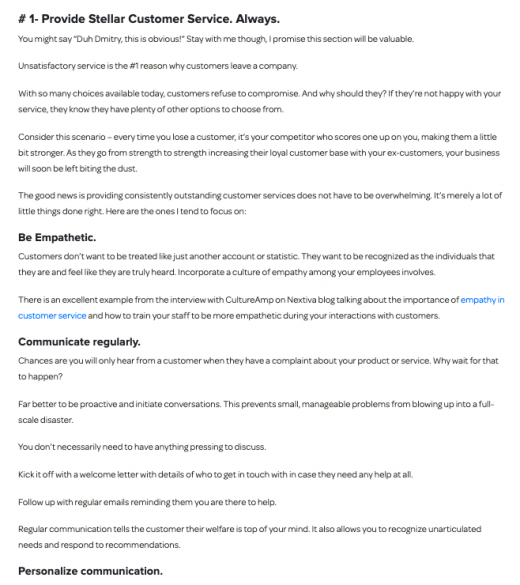4 Ways to Optimize Your Site to Rank on Google in 2019
4 Ways to Optimize Your Site to Rank on Google in 2019

Content marketing and optimization have come a long way since the early days of search. Simple tricks like keyword stuffing have fallen by the wayside as Google has become more enlightened in its ability to understand content. Here are the best four ways to optimize your site to rank on Google in 2019.
Marketers need to make more intelligent decisions about their content.
Let’s look at four areas in which optimization can play an important role in 2019 and beyond.
1. Content Optimization
Optimizing the content of page refers to anything that improves the quality of the content on a page. These changes make it easier for both your audience and search engines to understand what the page is about.
Properly address user intent.
Google continues to refine its ability to match user intent with relevant content. It’s no longer a question about having the best content, but rather having the best content that matches the intent behind the search term. Carefully analyze the SERP, its features, and PPC ads for hints on the most likely intent.
Thoroughly answer the questions associated with a search term.
People search Google to find answers to questions. Those questions aren’t always evident in the keywords people use. But you can find them in the “People also ask” (PAA) section of the search results.
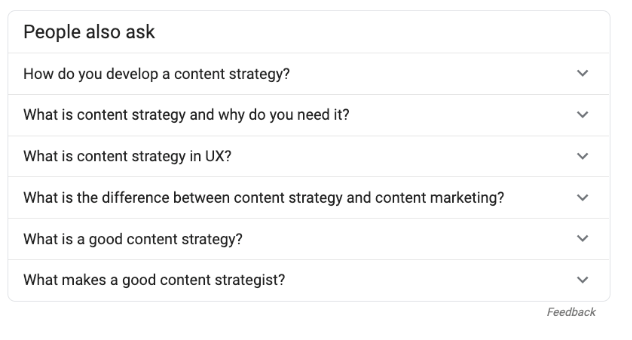
These are lists of frequently asked questions that Google has mapped to particular search terms. Clicking on any of these questions can lead to additional questions to include in your article. Google has done all the work, of which you can take advantage.
Proper internal linking with appropriate anchor text.
Internal linking provides the ideal opportunity to create clusters of content focused on a specific topic. It’s rare that a site can rank well with just one post on a topic. It’s equally unusual for a topic to be so shallow that one page can address all possible intents. Use internal links to create content clusters that address these intents.
Google crawls these pages and forms associations between them, based on the links, anchor text, and text surrounding the link. Ensure the anchor text for these links includes descriptive and highly relevant keywords. Avoid using terms like “click here.”
Orphan pages, those without any internal links pointing to them, are hard for both users and search engine to find. Although they may get indexed, like from a sitemap, the lack of internal links will impact its ranking potential. Use a tool like Screaming Frog SEO Spider to find these pages on your site.
Proper external linking.
Avoid linking to your SERP competitors of the keyword being targeted. A link is like a vote. When you link to the competition, you’re telling Google that their page is better than yours. Don’t help your competitors, regardless of their position in the SERP.
Avoid linking to SERP competitors for keywords that are closely related semantically. A well-written page can rank for a number of semantically related topics. Helping the competition ends up being self-defeating.
Ensure your article provides comprehensive topic coverage.
Create a topic model of the subject that you wish to cover. Evaluate the competition against this model to uncover content gaps that you can exploit. Apply this against your page as well, to ensure your content is the best on the web.
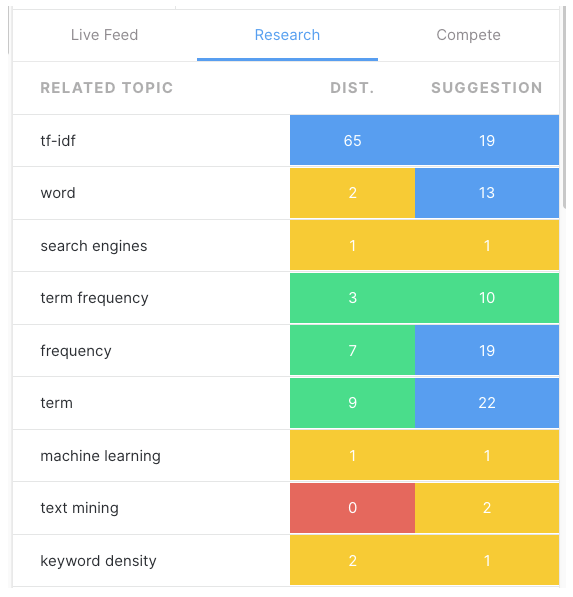
Manually creating a model for every topic is prohibitively time-consuming. An SEO content analysis tool like MarketMuse uses AI to speed up the process. This example above is from MarketMuse, which I tend to use quote often when doing content optimization.
2. Technical Optimization
Technical optimization usually refers to anything that helps ensure a website is properly crawled and indexed by search engines. However, it can also apply to any technical activity that improves a site’s ability to rank well.
Ensure robots.txt allows crawling.
Search engines can only index pages that they know about, so if they can’t crawl a page, it’s unlikely to be indexed. Likewise, they can rank pages that are not in their index.
Include the URL in the sitemap.
A sitemap is a file that provides information about pages on your site and helps search engines crawl it more intelligently. Adding the URL to your sitemap provides for faster discovery.
Avoid deep site architecture.
Limit the number of clicks it takes to each page to a maximum of four. Pages buried deeper than this are hard to reach, for both search engines and people. As a result, these pages see little traffic and are more likely not to get indexed. Screaming Frog Spider can help find these pages.
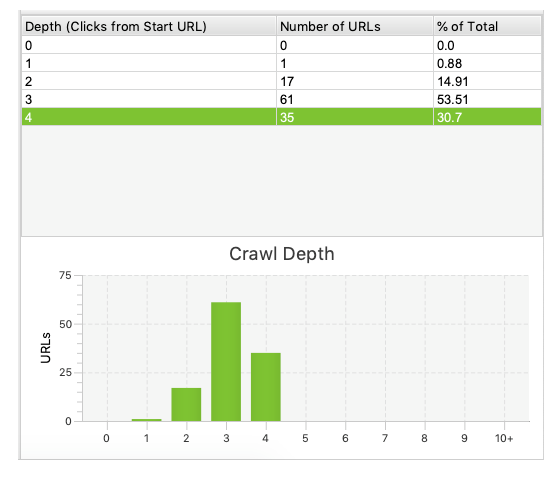
Speed up your web pages.
Page speed is a ranking factor for mobile searches that applies in specific situations. However, it’s universally accepted that visitors will quickly abandon a site that takes too long to load. There are a number of ways to address the issue, including:
- Compressing images
- Using reliable dedicated hosting
- Employing a content delivery network (CDN)
- Optimizing CSS code and its delivery
- Minifying Javascript, CSS, and HTML
- Avoiding number external services and poorly coded CMS plugins
These are just some general areas where gains are typically found when looking to speed up a website. Since every site is unique, consider a page speed testing tool like Google Pagespeed Insights or GTMetrix. These programs evaluate individual URLs and offer specific suggestions on how to improve page speed.
3. User Experience (UX) Optimization
UX optimization deals with any changes that will enhance the experience of consuming the content. Page speed can be considered a UX element because slow loading pages detract from the overall experience. However, since we’ve already covered that, let’s look at some others.
Meet Web Content Accessibility Guidelines (WCAG)
It’s good practice to ensure your site’s content meets WCAG guidelines. These guidelines have been created to help web developers ensure their content is more accessible to people with disabilities. Some of these ways include filling in “image alt text” tags to describe images using text for those who are visually impaired.
Use headers to organize information.
Headers and subheaders are not only great for organizing content, but they also make it easier for readers to scan. Plus, they give search engines a better understanding of the contents of a page.
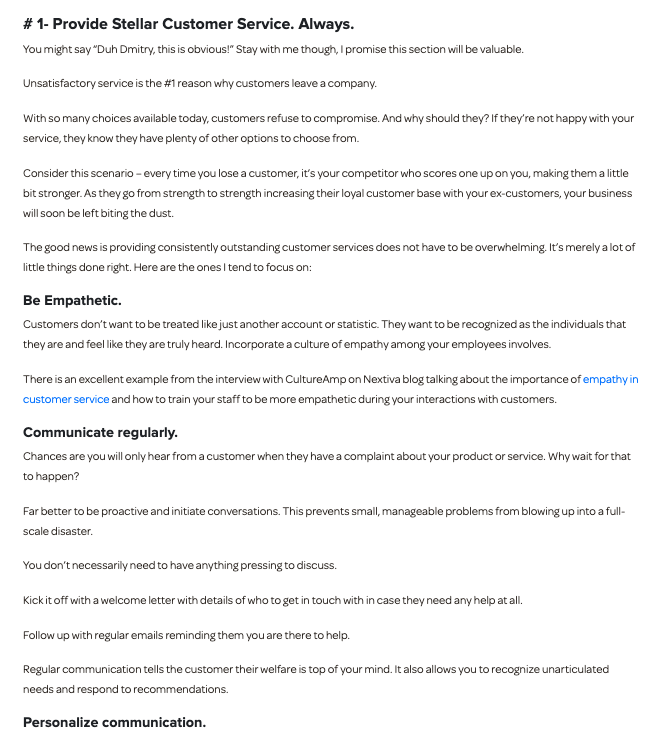
Pages should be device responsive.
In 2018, over 52% of web traffic came from mobile devices. Your site needs to adapt to the constraints of many different devices and format itself accordingly.
Design should be aesthetically pleasing.
Next to slow loading web sites, the greatest turn off for new visitors is one that’s ugly. Although beauty may be in the eye of the beholder, a functional site still needs to be easy to look at. Design and UX is not only about the visual aspects on the website but also the entire experience of a customer as they journey through your sign up flow and which pages they visit. For example a company called SalesMsg improves engagement and customer experience by integrating SMS texting in corresponding with their customers. This helps visitors come back to the website repeatedly after receiving SMS text notifications, repeated visits to pages on a website boost it’s ranking overall.
Make sure navigation elements are easily understood.
From a visual aspect, these elements need to be easy to comprehend. When using text as a navigation aid, use common words that are unambiguous and familiar.
Build in social sharing incentives.
Use elements like click-to-tweet and social sharing buttons to encourage engagement. Social is a great discovery tool. Not only are these components easy to incorporate, they increase your chance of gaining coveted backlinks from other sites.
Social shares is actually a very important metric which most brands forget, I spoke to Jeremy Boudinet from Nextiva who about this, here is how he put it:
“If you write an article with a high number of social media shares and publicize that number on the post itself, that screams ‘this is an authoritative piece’ and dramatically amplifies the likelihood of generating passive backlinks and further social sharing over time.”
Use images that convey major points of the post.
Avoid using stock images just for the sake of having an image. Some people are visual learners, so use images purposefully as another way of making your point.
Over 25% of Google searches are image searches. Although click through rates are less, consider optimizing for this traffic source. Optimizing images is a lot simpler than page optimization. Elements to focus on are the image filename, alt text attribute, image caption, and surrounding text content.
Ensure every page has a clear CTA.
Technically this won’t help your page to rank better. But, since you’re doing all this work anyways, it makes sense to maximize your conversion opportunities. Adam Legas who is the founder of Nanohydr8 equates this with a call to action in your emails, if the subject line doesn’t capture their attention then the email will not be opened and your overall deliverability of campaigns will suffer. Same with content and websites, if there is not clear CTA or action a lot of time people will not engage with your content.
4. MetaData Optimization
Generally speaking, metadata isn’t as important as it once was. However there are some elements that should be optimized.
Optimize title tags for search.
Title tags are an important factor in helping Google understand the content on a page. It’s a search visitor’s first experience of your site, so make sure to get this right.
Google limits title displays to a maximum of 600 pixels which works out to be about 50 to 60 characters. Put important keywords first, but make sure it’s still readable by humans.
Use concise and descriptive URLs.
WordPress automatically converts the post title into the URL, but it’s not always the best choice. Take for example this article on my blog, “How To Write a Press Release in 7 Steps [w/ Examples and; Templates].” Since the keyword being targeted is “how to write a press release”, it makes sense to shorten this long and unwieldy URL to “https://blog.justreachout.io/how-to-write-press-release/”.

Create enticing meta descriptions.
Meta description isn’t a ranking factor, but a good one will increase your all-important click through rate. So give them a reason to click.
The description in this example encourages people to click. Why? Because they’re curious about the “crucial other half.” That fear of missing out is an ancient and proven fear upon which you can capitalize.
Employ schema markup where appropriate.
Pages don’t get extra points for using schema markup. But anything you can do to make it easier for Google to understand your content is a step in the right direction. Schema markup code, added to your website helps search engines offer additional information to users.
That richer search experience, can bring much more relevant traffic than a basic SERP entry. Here’s one for comparison.
Although there are over 600 different types of schema, there are generally only a handful with which most content marketers should familiarize themselves. Those include organization, local business map, product, breadcrumbs, article, video, event, recipe, and FAQPage. If you use WordPress, consider the Yoast SEO plugin as it offers support for a number of popular schema.
Conclusion
Google’s search algorithms continue to increase in sophistication, bringing with it new opportunities to improve content. There are many ways to optimize a web page, but they all fall into these four main categories. Follow the Pareto principle and focus your initial optimization efforts on the 20% that’s going to give you 80% of the results.
The post 4 Ways to Optimize Your Site to Rank on Google in 2019 appeared first on ReadWrite.
(40)

